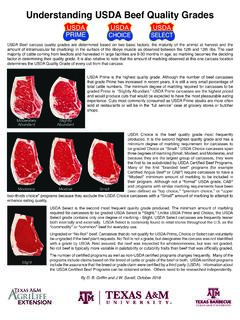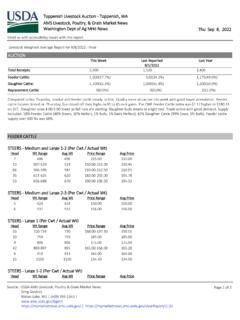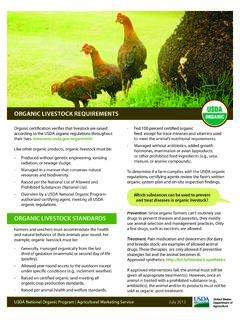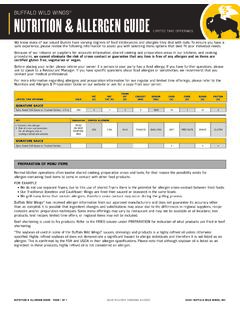Transcription of This Study Guide will help you prepare for your ServSafe
1 This Study Guide was made By Mike s Food Safety Class LLC for the Manager ServSafe 7th Ed. Class and 1 testing only This Study Guide will help you prepare for your ServSafe class. You are now enrolled in a Manager ServSafe Food Safety Certification course. This course will meet the required 8-hour state requirements that may be required for your jurisdiction. Mike s Food Safety Class have put together this Study Guide to help you have a general food safety knowledge prior to attending class. We cover a lot of information in this course. This Study Guide is just a summary of the information that we cover. We highly recommend you use this Study Guide prior to taking the class. There is no guarantee of passing this exam. There are no refunds issued. This Study Guide was made By Mike s Food Safety Class LLC for the Manager ServSafe 7th Ed.
2 Class and 2 testing only Chapter 1 Study Guide Who needs to be certified ? The requirement is that the person in charge must become a certified Food Protection Manager. The FDA Food Code requires that the person in charge of a foodservice operation become a certified Food Protection Manager. That person must always be onsite during operating hours. A certified Food Protection Manager must show that he or she has the required knowledge by passing a test from an accredited program. The program must be accredited by an agency approved by a Conference for Food Protection. Completing the ServSafe Manager Course and passing the ServSafe Food Protection Manager Certification Examination meets this requirement. Why is it so important to become certified ? Centers for Disease Control and Prevention Study suggests that the presence of a certified Food Protection Manager reduces the risk of a foodborne illness outbreak for an establishment.
3 The Study also suggests that it was a distinguishing factor between restaurants that experienced a foodborne illness outbreak and those that had not. In addition, the FDA s Retail Food Risk Factor Studies suggest that the presence of a certified manager has a positive correlation with more effective control of certain risk factors, such as poor personal hygiene, in different facility types. Challenges to Food Safety A food borne illness is a disease transmitted to people through food. An illness is considered an outbreak when: Two or more people have the same symptoms after eating the same food. An investigation is conducted by state and local regulatory authorities. The outbreak is confirmed by laboratory analysis. The biggest challenges we must overcome in food safety are: Time and Money Pressure to work quickly can make it hard to take the time to follow food safety practices This Study Guide was made By Mike s Food Safety Class LLC for the Manager ServSafe 7th Ed.
4 Class and 3 testing only Language and Culture - Your staff may speak a different language than you do, which can make it difficult to communicate. Cultural differences can also influence how food handlers view food safety. Literacy and Education - Staff often have different levels of education, making it more challenging to teach them food safety Pathogens - Illness-causing microorganisms are more frequently found on food that once was considered safe. Unapproved suppliers - Food that is received from suppliers that are not practicing food safety can cause a foodborne-illness outbreak. High-risk customers - The number of customers at high risk for getting a foodborne illness is increasing. An example of this is the growing elderly population.
5 Staff turnover - Training new staff leaves less time for food safety training Costs of foodborne Illness Loss of customers and sales Loss of reputation Negative media exposure Lowered staff morale Lawsuits and legal fees Staff missing work Increased Insurance Premiums, Staff retraining, and even death. The ServSafe program will provide the tools needed to overcome the challenges in managing a good food safety program. If food is not handled correctly, it can become unsafe. These are the five most common food-handling mistakes, or risk factors, that can cause foodborne illness. 1. Purchasing food from unsafe sources 2. Failing to cook food correctly 3. Holding food at incorrect temperatures 4. Using contaminated equipment 5. Practicing poor personal hygiene This Study Guide was made By Mike s Food Safety Class LLC for the Manager ServSafe 7th Ed.
6 Class and 4 testing only Except for purchasing food from unsafe sources, each risk factor for foodborne illness is related to four main factors: Time-temperature abuse - When food has stayed too long at temperatures good for pathogen growth. Food has been time-temperature abused when: It has not been held or stored at correct temperatures It is not cooked or reheated enough to kill pathogens It is not cooled correctly Cross-contamination - When pathogens are transferred from one surface or food to another. Cross-contamination can cause a foodborne illness when: Contaminated ingredients are added to food that receives no further cooking Ready-to-eat food touches contaminated surfaces A food handler touches contaminated food and then touches ready-to-eat food Contaminated cleaning cloths touch food-contact surfaces Poor personal hygiene - Poor personal hygiene can cause a foodborne illness when food handlers: Fail to wash their hands correctly after using the restroom Cough or sneeze on food Touch or scratch wounds and then touch food Work while sick Poor cleaning and sanitizing - Equipment and utensils are not washed, rinsed, and sanitized between uses.
7 Food-contact surfaces are wiped clean instead of being washed, rinsed, and sanitized Wiping cloths are not stored in a sanitizer solution between uses Sanitizer solution was not prepared correctly TCS foods are foods that do need time and temperature to keep them safe TCS = Temperature Control for Safety. The list of TCS food includes the following: Milk and dairy products Shell eggs (except those treated to eliminate Salmonella spp.) Meat: beef , pork, and lamb Poultry Fish Shellfish and crustaceans This Study Guide was made By Mike s Food Safety Class LLC for the Manager ServSafe 7th Ed. Class and 5 testing only Baked potatoes Heat-treated plant food, such as cooked rice, beans, and vegetables Tofu or other soy protein; synthetic ingredients, such as textured soy protein in meat alternatives Sprouts and sprout seeds Sliced melons; cut tomatoes; cut leafy greens Untreated garlic-and-oil mixtures Ready-to-eat food is food that can be eaten without further: Preparation Washing Cooking Ready-to-eat food includes: Cooked food Washed fruit and vegetables Deli meat Bakery items Sugar, spices, and seasonings Populations at High Risk for Foodborne Illnesses These people have a higher risk of getting a foodborne illness: 1.
8 Elderly people - Elderly people are at high risk because their immune systems have weakened with age. 2. Preschool-age children - Very young children are at high risk because they have not built up strong immune systems. 3. People with compromised immune systems - People with compromised immune systems include: People with cancer or on chemotherapy People with HIV/AIDS Transplant recipients People taking certain medications Managers must set up standard operating procedures that focus on the measures listed above. Then they must train their staff on these procedures and monitor them to make sure the procedures are followed. This Study Guide was made By Mike s Food Safety Class LLC for the Manager ServSafe 7th Ed. Class and 6 testing only Keeping Food Safe Focus on these measures: Controlling time and temperature Preventing cross-contamination Practicing personal hygiene Purchasing from approved, reputable suppliers Cleaning and sanitizing Training and monitoring: Train staff to follow food safety procedures Provide initial and ongoing training Provide all staff with general food safety knowledge Provide job specific food safety training Retrain staff regularly Monitor staff to make sure they are following procedures Document training Government agencies: The Food and Drug Administration (FDA) - The Food and Drug Administration (FDA) inspects all food except meat, poultry, and eggs.
9 The agency also regulates food transported across state lines. In addition, the agency issues the FDA Food Code, which provides recommendations for food safety regulations department of agriculture ( usda ) - The department of agriculture ( usda ) regulates and inspects meat, poultry, and eggs. It also regulates food that crosses state boundaries or involves more than one state. Centers for Disease Control and Prevention (CDC) - conduct research into the causes of foodborne-illness outbreaks. Public Health Service (PHS) - conduct research into the causes of foodborne-illness outbreaks. State and local regulatory authorities - State and local regulatory authorities write or adopt code that regulates retail and foodservice operations. OSHA - Regulate your MSDS / SDS This Study Guide was made By Mike s Food Safety Class LLC for the Manager ServSafe 7th Ed.
10 Class and 7 testing only Chapter 2 Study Guide There are three categories that food contamination falls in Biological, Chemical, and Physical. How Contamination Happens Contaminants come from a variety of places: Animals we use for food Air, contaminated water, and dirt o Contaminants can cause foodborne illness or result in physical injury. Contaminants are found in the animals we use for food, the air, water, dirt; and they occur naturally in food, such as bones in fish People Deliberately - Food can be contaminated on purpose. Accidentally - Most food is contaminated accidently. Examples of accidental contamination include food handlers who do not wash their hands after using the restroom, and then contaminate food and surfaces with feces from their fingers; and food handlers who pass contaminants through illness.




